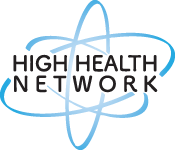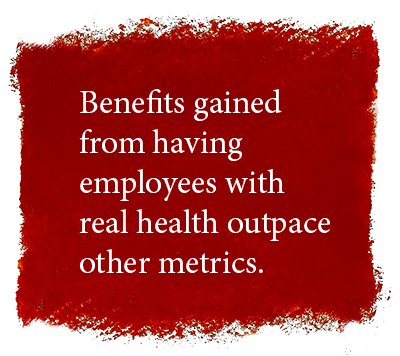Real ROI Is Hard To Find: Valuing Employee Wellness
Part 3 of the Radical Concepts in Health series
by Joyce Young, MD, MPH
Managing Director, Advanced Wellness Systems
The classic question
“What is the return on investment for employee wellness programs?”
In our executive focus groups, if we can’t give executives a simple answer within a few nanoseconds they roll their eyes and disengage.
This is a mistake.
To successfully manage the business issues that executives tell us are keeping them up at night, they need employees who are energetic, creative, and optimistic. They need people who can solve problems effectively and manage change.
Not understanding how to find or value ROI for wellness programs distorts executives’ decision making about investments that stand to provide their businesses a competitive edge.
An unusual answer
Return on investment for employee wellness programs can’t be found on a profit and loss report. Determining this ROI is possible, but it takes data and analysis. Because it’s complex, many companies do not pursue it.
ROI for employee wellness does exist and can be found—if you know where and when to look.
Real ROI for employee wellness
Business leaders understandably want to know about ROI for programs they’re considering. We know, based on years of field experience with program implementation and evaluation, that ROI for wellness programs is hard to find.
So we created a quick ROI explainer video to reveal what to look for as well as where and when, based on the best industry research we’ve found. It shows all you need to know in about two minutes.
Prefer to read the details? Finding ROI requires identifying employees who are similar in demographics and health status levels and determining if those who participate in wellness program activities have less health care services utilization and/or costs, less lost time from work, and better work contributions.
The findings often show that health services utilization is somewhat better for program participants and that lost time from work and work contributions are substantially better for participants.
While health care costs grab all the attention, in reality the greater return is from improvements in work contributions and innovation.
Real health is actually more important in today’s business world
A more useful way to think about the potential for benefit from employee health programs is to consider the level of real health participants of these programs are achieving along with the number of employees who exhibit real health among the company’s entire employee population.
Today’s business world is so demanding that the benefits gained from having employees with real health outpace other metrics. I’ll get to those in a moment. But first, we need to look at what “real health” is.
What is “real health”?
Real health is a state of high capacity and overall well-being characterized by effective mental focus, stamina, energy, adaptability, and emotional composure as well as resistance to common illnesses. It reflects balance and optimal performance across multiple life dimensions. It also reflects the level of health and energy an individual has rather than their levels of diseases and health risks.
Real health applies to individuals and can be used to determine the strength of health of the entire employee population. While we have gigantic data collections on the prevalence of diseases of all kinds, data on the percentage of people who have high states of health and well-being are miniscule. Within the general population, one of the few researchers in this area found that about 20% of U.S. adults meet the criteria for flourishing (Fredrickson, 2009).
Real health arises when people adopt and sustain personal practices that optimize and integrate all aspects of life, including the physical, mental, emotional, purpose and life direction dimensions. They develop confidence in their abilities to re-balance and heal whether they work with health professionals in the process or not (Young, 2019).
It’s rare to understand what real health is because most of us think of health in outdated ways.
Measuring real health
Measuring real health involves determining the health and energy levels of employees through analysis of their responses to research questions and reporting them as a percentage between 0 and 100 percent. Health care services utilization and/or costs, lost time from work, and work performance and contributions can be evaluated according to the employee’s level (percentage) of health and energy.
Real health’s business value
In one study, employees who have high health levels showed:
4 times less health services utilization,
6 times less lost time from work, and
8 times better work contributions than employees at low health levels (Keyes & Grzywacz, 2005).
In our own non-published data trends, we’ve found that employees with high health have three times less health services utilization, three times less lost time from work, and eight times better work contributions than those at low health levels.
Higher innovation and work performance are also seen among employees who have high levels of health and well-being (Wu et al, 2016).
Executives tell us they want more innovation for their businesses, and of course they do. It leads to a competitive edge.
Why the driver of this edge often goes unnoticed
Real health is a nearly hidden driver because our focus is on health pathology and not on our potential for realizing high overall capacity and high levels of health and well-being. This limited way of thinking is so pervasive that we are not even aware of it.
Yet the way we see health shapes our programs. Because we perceive health as a problem, our wellness efforts center on reducing risks and mitigating disease. These efforts have not delivered the outcomes of high capacity that we have hoped for. We’re working on problems but not increasing employee health and well-being levels, which lead to greater innovation.
A more strategic course of action is to build personal energy, mental focus, stamina, optimism, and high capacity that also have—as collateral benefits—the ability to reduce the health problems of our concerns.
Real health is possible—not just for top executives, but also for employees
Science-based methods now exist for restoring mental focus, building adaptive capacity for high demand situations, moving and fueling the body optimally, and achieving emotional and mental balance (Young, 2019).
Top business leaders have had access to these practices for years at exclusive executive development centers. Because these practices have not been affordable or scalable for large numbers of employees until recently, very few companies have tapped them.
When delivered effectively, these new techniques represent an upgrade in employee wellness programming—one that successful companies cannot afford to ignore. Moreover, the value delivered by such programs stands to set businesses apart.
Real health is now a business imperative
Executives are understandably concerned with problems that keep them up at night involving profits, investments, talent, culture, trends, competition, and resources. Most overlook real health, which underpins all of these and can yield a powerful edge for their companies.
Employees who know how to manage their health experience less health services utilization, less lost time from work, and better work contributions than those who don’t.
High health and high personal capacity creates the dynamic balance, stability, and flexibility required to prosper, especially in our present time of constant change, disruptive economies, and escalating societal demands. Having real health makes it possible for people to do what matters most to them (Young, 2018).
Real health may be a surprising way to build innovation in business, but it’s enduring, valuable, and well worth the modest investment.
Joyce M. Young, MD, MPH
Managing Director, Advanced Wellness Systems
Lead expert for the High Health Network
Dr. Young is a curator of innovative practices for vibrant living and a champion of high health, well-being, and the pursuit of mastery. She founded Advanced Wellness Systems and created the High Health Network to provide effective, science-based, affordable solutions to high-health leaders seeking greater health and well-being for their teams. Dr. Young is board certified in General Preventive Medicine and Public Health and is the author of numerous peer-reviewed publications on wellness program design and outcomes. A voracious reader, she also loves to laugh, jog, practice piano, garden, brew kombucha, and enjoy delicious home-cooked meals.
References
Fredrickson, B. L. (2009). Positivity. New York, NY: Crown Publishers.
Keyes, C. L. M. & Grzywacz, J. G. (2005). Health as a Complete State: The Added Value in Work Performance and Healthcare Costs. Journal of Occupational and Environmental Medicine, Volume 47, Number 5, May 2005, 523–32.
Wu, H. et al. (2016). Overall Well-Being and Supervisor Ratings of Employee Performance, Accountability, Customer Service, Innovation, Prosocial Behavior, and Self-Development. Journal Of Occupational And Environmental Health, Volume 58, Number 1, January 2016, 35-40.
Young, J. M. (2018). A New Way of Seeing: Health Is a Resource, Not a Problem. Retrieved from: http://highhealthnetwork.com/a-new-way-of-seeing-health-is-a-resource-not-a-problem-full.
Young, J. M. (2019) A Bias For Action: Practices For Health Empowerment. Retrieved from: http://highhealthnetwork.com/a-bias-for-action-practices-for-health-empowerment






